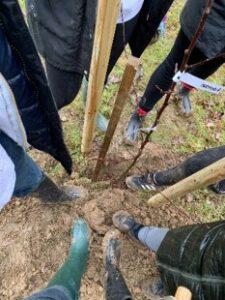A group of children in care were given the opportunity to plant trees as part of a nature conservation project.
Why?
Access to nature is linked to well-being. In 2021 98% of young people in Hertfordshire aged 11-18 said they spent some time in nature every week. This is a Bright Spot of Practice.
The day planting trees enabled young people to take part in outdoor activities and to be a volunteer.
What?
-
- A local nature conservation project invited Hertfordshire’s children services to be part of a project planning trees. This was an unexpected offer but after the success of the day staff are planning to offer more sessions to young people.
- During a half term holiday 13 young people aged 12-18 spent the day working at the centre, They came from various placements – foster carer and independent sector placements. 4 young people from residential placements were supported by their key workers.
- The opportunity was open to all children in care and over 40 young people expressed an interest.
- The young people worked with staff from the centre to prepare the area, and to dig and plant their tree.
- In addition to planting their tree they had the chance to learn about other nature conservation schemes, explore paths through the woods and play in the stream.
- All the young people enjoyed the day- despite the weather – especially the toasted marshmallows to round off the day.
Plans are being made for a nature walk at Easter and to plant more trees
What?
-
- A local nature conservation project invited Hertfordshire’s children services to be part of a project planning trees. This was an unexpected offer but after the success of the day staff are planning to offer more sessions to young people.
- During a half term holiday 13 young people aged 12-18 spent the day working at the centre, They came from various placements – foster carer and independent sector placements. 4 young people from residential placements were supported by their key workers.
- The opportunity was open to all children in care and over 40 young people expressed an interest.
- The young people worked with staff from the centre to prepare the area, and to dig and plant their tree.
- In addition to planting their tree they had the chance to learn about other nature conservation schemes, explore paths through the woods and play in the stream.
- All the young people enjoyed the day- despite the weather – especially the toasted marshmallows to round off the day.
Plans are being made for a nature walk at Easter and to plant more trees


Participation worker‘It moved the young people out of their comfort zone and into something new’





